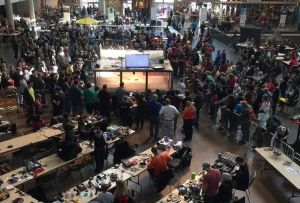GettingStarted
There is so much to do!
There are a lot of guides to help new builders get stared. Everyone's goals and skills are different so no single guide will work for everyone. Some people love the design process while others love the build. Take your time and gather the bits and pieces that work for you. There are a lot of different approaches to building your first robot.
Getting Started Guides
RioBots
Build an Antweight
New Zealand guide to getting started
Reddit on getting started
RobotBattles
SparkFun
Go to an event
Many new builders get hooked by watching robots on TV or on YouTube. There is a lot you can learn from watching matches but there are so many potential decisions around bot design, components, rules and a hundred other things that it can be difficult to know where to start. The first think that every new builder should do is to go to an event and see how things are done in the real world. There are hundreds of great videos out there showing robot combat, but you'll learn a lot about things by attending an event. Even if you don't have a robot, you should ask the event organizer if it is OK to walk around the pits and talk to the builders. Watching them prepare for their matches and repairing robot damage will help you figure out what you'll need for your first event.
Pick a weight class
Once you've been to an event and decided to built a robot, you need to pick a weight class for your first build. Take into consideration which weight classes are supported in the event(s) you plan to attend, your budget, and your building skills. Generally things get more expensive as they get bigger and the building / fabrication requirements are very different for a 1-pound robot vs. a 30-pound robot. Start with something that you think you'll be able to complete and if you have fun then build a second and third robot.
Pick a basic design
Building and competing with your robot is supposed to be fun. Pick a design that you will enjoy but be sure to do something within your capabilities. Building a pneumatic flipper with no prior experience isn't a good choice for your first bot. Know yourself and pick a design that is fun but also something that you can do.
Pick components
Some people spend a ton of time picking motors and batteries and all the things that go into your first robot. It pays to take some time and make some informed choices but event advanced builders iterate and discover new components to improve their bots. Don't let 'perfect be the enemy of good'. Pick things that work and iterate and make improvements over time.
Build and Test your robot
As you put your robot together you should be testing it but safety is always important. Do a wheels-up test of your drive system to make sure the drive system is working as expected. If your bot has a weapon you want to make sure that the failsafe is working correctly. Test the failsafe with just the motor first. Once it is working correctly you can test with the weapon attached. Be sure to test it safely. Ideally you have a big sheet of polycarbonate to stand behind when testing but there are other ways to stay safe. Some builders will set up a camera to record the bot.
